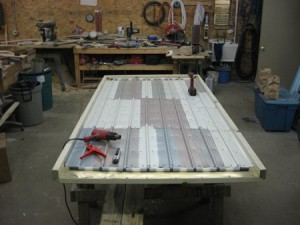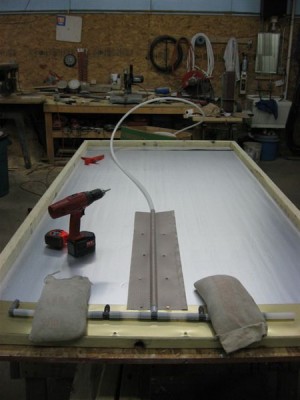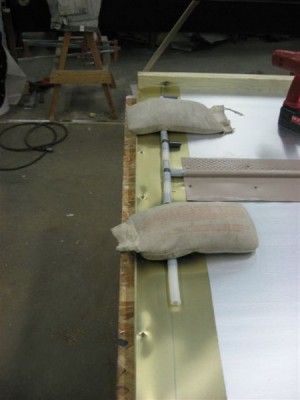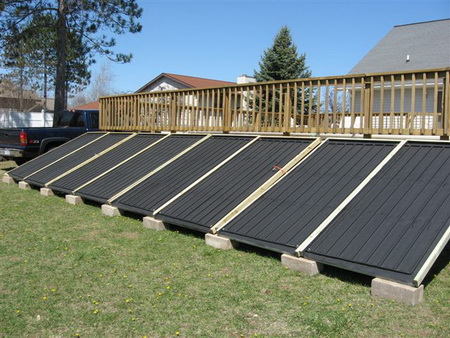Pool Solar Collectors
 I built an 8-Panel array for a friend’s pool last summer, with several reasons for undertaking the project. I thought pools would be a great application for solar heat and imagined my two high school age boys might be interested in building more for some small part-time income (that was wishful thinking). The final reason was I always seem to build or design something new, or duplicate an expensive commercial product for much cheaper, and later a friend is the benefactor of refinements or improvements over my first design. This time I planned to learn from this project before building my own solar collector array.
I built an 8-Panel array for a friend’s pool last summer, with several reasons for undertaking the project. I thought pools would be a great application for solar heat and imagined my two high school age boys might be interested in building more for some small part-time income (that was wishful thinking). The final reason was I always seem to build or design something new, or duplicate an expensive commercial product for much cheaper, and later a friend is the benefactor of refinements or improvements over my first design. This time I planned to learn from this project before building my own solar collector array.
I had a lot of 5/8″ PEX left over from a major expansion to my truck dealership, so designing the system to use this tubing reduced the cost of the collectors significantly. The two options commonly used for solar collectors are; manifold / riser design, and serpentine. I felt the manifold and riser design was easier when building multiple 4′ x 8′ panels and “mating” them on site. This allowed for panel sizes that could be handled with a couple people during collector assembly, paint, and final assembly on site. All tubing was set up for “drain back”, although on site they would not drain back as installed. We did drain them at the same time the pool was prepped for the winter.
I used a plastic irrigation “T” fitting for the manifold to riser connections, heating the PEX with a heat gun to soften it enough to force the “barbed” plastic fitting into the PEX. With the tight fit, there was no need to use any clamps at the joints (at least not in this pool application). The one advantage of PEX for pools is it is chemical resistant. Copper, although more conductive and desirable for solar collectors, will react to pool chemicals, causing discoloration of the pool water.
Details of the construction of the collectors can be found at my friend Gary’s website;
http://www.builditsolar.com/Projects/PoolHeating/TomCollector/TomPEXCollector.htm
I will touch on some specifics not discussed in my article on Gary’s site.
Performance
 These are “unglazed” panels, which are the norm for pool solar collectors. The design used here, with the PEX and plastic fittings, will not work in a glazed panel. We found this out the hard way, as during any stagnation in the summer time, the heat inside a glazed panel exceeds the melt point of the plastic irrigation fittings. I believe the PEX will handle the heat in absence of a “weak point fitting”, so serpentine designs, having no connections inside the glazed panel, should hold up. Gary, from Build it Solar, has several projects, his own and other builders, that have held up fine using PEX in a glazed panel.
These are “unglazed” panels, which are the norm for pool solar collectors. The design used here, with the PEX and plastic fittings, will not work in a glazed panel. We found this out the hard way, as during any stagnation in the summer time, the heat inside a glazed panel exceeds the melt point of the plastic irrigation fittings. I believe the PEX will handle the heat in absence of a “weak point fitting”, so serpentine designs, having no connections inside the glazed panel, should hold up. Gary, from Build it Solar, has several projects, his own and other builders, that have held up fine using PEX in a glazed panel.
Talking with several builders purchasing aluminum absorber from me for pools, it’s evident many do not understand the massive heat requirement of a pool. Let’s review some basic heating facts. 1 BTU is the amount of energy it takes to raise the temperature of one pound of water, one degree. Now that’s not one gallon of water, but one pound of water. Since water weighs a bit over 8 lbs. per gallon, it takes about 8 BTU’s to raise a gallon of water one degree. Our basic homebuilt 4′ x 8′ solar collector might produce 3,000 to 3.500 BTU’s an hour in good sunlight. Taking a normal sunny day in Northern Michigan (actually the Upper Peninsula of Michigan), we may see enough sun to start the collector at 9 AM, and it will go off about 5 PM during the summer. Figuring for lower efficiency during the first couple and last couple hours, let’s use 7 hours of full production for our calculations on production. 7 hours at 3,250 BTU’s (averaged from best collector to average one), we would see 22, 750 BTU’s of heat from one panel. Compiling the production of the 8-panel array I built for this pool, we would see 182,000 BTU’s of heat per sunny day. Sounds impressive, but lets figure out how much we’re going to heat the pool with this energy.
A normal size pool in my area is between 12,000 and 18,000 gallons. Just for the record, there’s about 7.5 gallons of water per cubic foot. If you can figure out the amount of cubic feet of your pool, you can determine the gallons of water in your pool. My particular pool had 16,000 gallons, which converted to pounds of water, is 128,000 pounds of water. That means it takes 128,000 BTU’s to raise my pool one degree. With 182,000 BTU’s of solar collector production “on a good day” we are barely raising the pool temperature a degree per day.
In Summary
 A pool solar collector will help offset your heating expense but, like a lot of things relating to renewable energy, there are a lot of ways to make the solar collector create more impact to your bottom line. Heat is lost in every direction from the water in your pool. It’s lost out the bottom, sides and the top. I read a good book published by the University of Alaska about heat, energy and insulation (actually it had a lot more, but this is what relates to this discussion). One theory the book reveals about heat that many, including me, didn’t realize; HEAT DOES NOT RISE. Hot air rises, but heat moves in every direction. If you have a pool that has the liner sitting on the ground, you are likely losing more heat to the ground than you are out the top or sides, as the ground is much more heat conductive than air. This is one of the reasons for the new mindset (in comparison to the late 80’s and early 90’s) about insulation under “in-floor heat” on concrete slabs. Most builders didn’t install insulation under the slabs years ago. Now, it’s code in many areas, requiring insulation under the concrete. The same applies to your pool.
A pool solar collector will help offset your heating expense but, like a lot of things relating to renewable energy, there are a lot of ways to make the solar collector create more impact to your bottom line. Heat is lost in every direction from the water in your pool. It’s lost out the bottom, sides and the top. I read a good book published by the University of Alaska about heat, energy and insulation (actually it had a lot more, but this is what relates to this discussion). One theory the book reveals about heat that many, including me, didn’t realize; HEAT DOES NOT RISE. Hot air rises, but heat moves in every direction. If you have a pool that has the liner sitting on the ground, you are likely losing more heat to the ground than you are out the top or sides, as the ground is much more heat conductive than air. This is one of the reasons for the new mindset (in comparison to the late 80’s and early 90’s) about insulation under “in-floor heat” on concrete slabs. Most builders didn’t install insulation under the slabs years ago. Now, it’s code in many areas, requiring insulation under the concrete. The same applies to your pool.
In my particular test with pool solar collectors, we had several factors impact the end results (or perceived results) of the array. We had an unusually cold summer. I think we were losing more than a degree a day due to outside temps. The pool owner had a good cover, but no side insulation, and the liner was sitting on the ground. In the end, the solar collectors didn’t “wow” the pool owner, as they expected to see quantitative results. Had they done more initially to save energy, with good insulation under the pool and on the sides, the output of the collectors would have been more noticeable.
If this information accomplishes nothing more, I hope it helps anyone thinking about building solar collectors for their pool. If a prospective builder knows how much heat an average collector puts out, and how much it takes to heat large quantities of water, they will not have unrealistic expectations of a project their likely to put significant time and money into.
